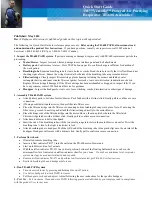
127915-YIM-A-0405
Unitary Products Group
53
Start the supply air blower motor. Adjust the resis-
tances in both the supply and the return air duct sys-
tems to balance the air distribution throughout the
conditioned space. The job specifications may require
that this balancing be done by someone other than the
equipment installer.
To check the supply air CFM after the initial balancing
has been completed:
1.
Remove the two 5/16" dot plugs from the blower
motor and the filter access panels shown in the
Dimensions and Clearances Figure 12.
2.
Insert at least 8" of 1/4 inch tubing into each of
these holes for sufficient penetration into the air
flow on both sides of the indoor coil.
NOTE:
The tubes must be inserted and held in a posi-
tion perpendicular to the air flow so that veloc-
ity pressure will not affect the static pressure
readings.
3.
Using an inclined manometer, determine the pres-
sure drop across a dry evaporator coil. Since the
moisture on an evaporator coil may vary greatly,
measuring the pressure drop across a wet coil
under field conditions would be inaccurate. To
assure a dry coil, the compressors should be deac-
tivated while the test is being run.
4.
Knowing the pressure drop across a dry coil, the
actual CFM through the unit can be determined
from the curve in Pressure Drop vs. Supply Air
CFM Figure 18.
After readings have been obtained, remove the tubes
and reinstall the two 5/16" dot plugs that were removed
in Step 1.
NOTE:
DE-ENERGIZE THE COMPRESSORS BE-
FORE TAKING ANY TEST MEASUREMENTS
TO ASSURE A DRY INDOOR COIL.
OPERATION
SEQUENCE OF OPERATIONS OVERVIEW
For these units, the thermostat makes a circuit
between "R" and "Y1" for the first stage of cooling.
The call is passed to the unit control board (UCB),
which then determines whether the requested opera-
tion is available and, if so, which components to ener-
gize.
For gas heating, the UCB monitors the "W1" call but
does not handle the operation of the gas furnace. An
ignition control board controls the gas heater operation.
For electric heat units, the UCB passes the call to the
electric heater.
In both cases, when the "W1" call is sensed, the indoor
air blower is energized following a specified heating
delay.
If at any time a call for both heating and cooling are
present, the heating operation will be performed. If
operating, the cooling system is halted as with a com-
pletion of a call for cooling. Heating always takes prior-
ity.
COOLING SEQUENCE OF OPERATION
CONTINUOUS BLOWER
By setting the room thermostat fan switch to "ON," the
supply air blower will operate continuously.
FIGURE 18 - PRESSURE DROP ACROSS A DRY
INDOOR COIL VS SUPPLY AIR CFM
FOR ALL UNIT TONNAGES
PRESSURE DROP ACROSS A DRY COIL VS SUPPLY AIR CFM
0.05
0.15
0.25
0.35
0.45
0.55
0.65
4000
5000
6000
7000
8000
9000
10000
11000
12000
NOMINAL AIR FLOW (CFM)
PRESSURE DROP (IWG)
DR180
DR300
DR240
Failure to properly adjust the total system air
quantity and static pressure can result in
extensive system damage.
















































